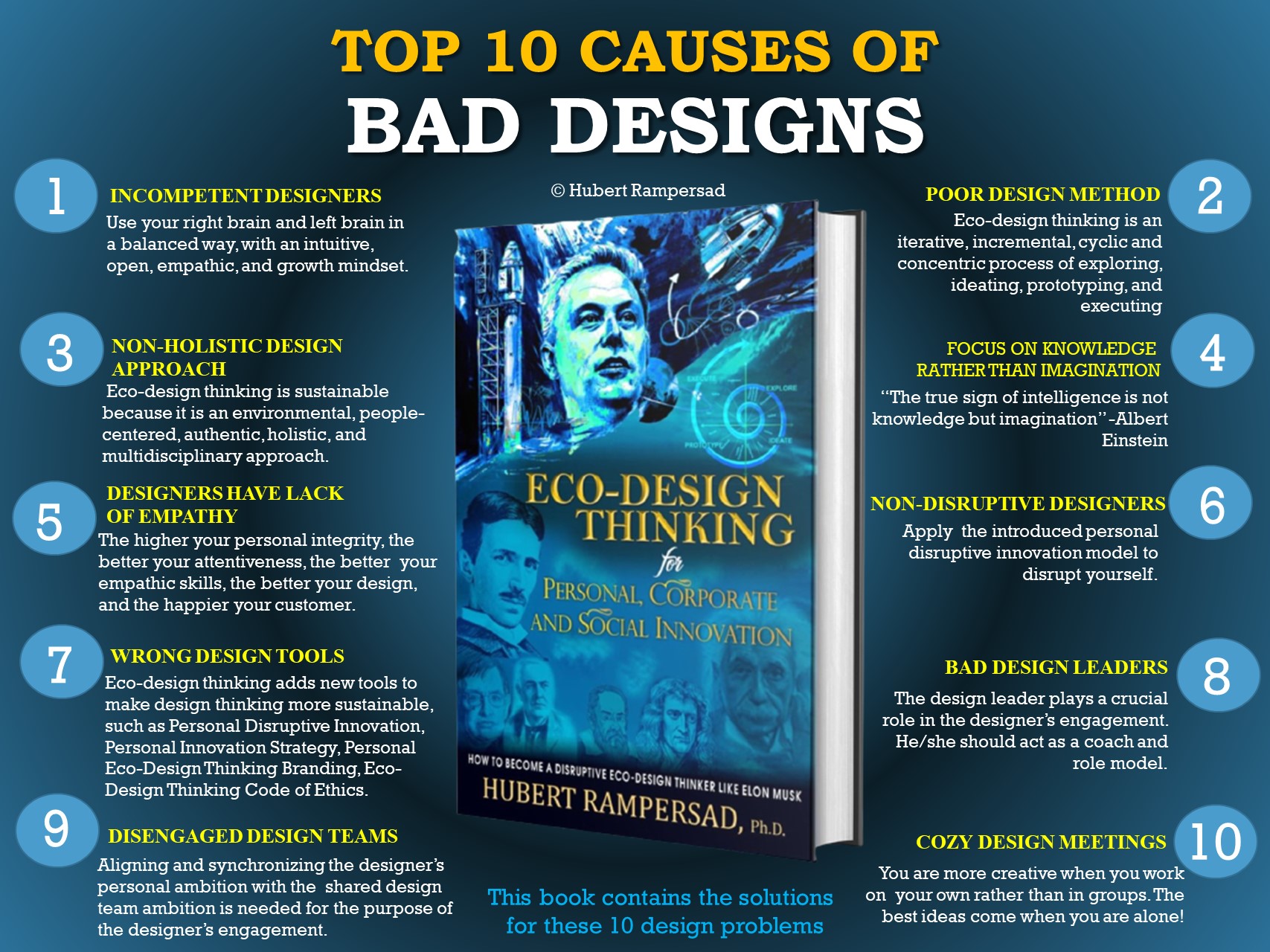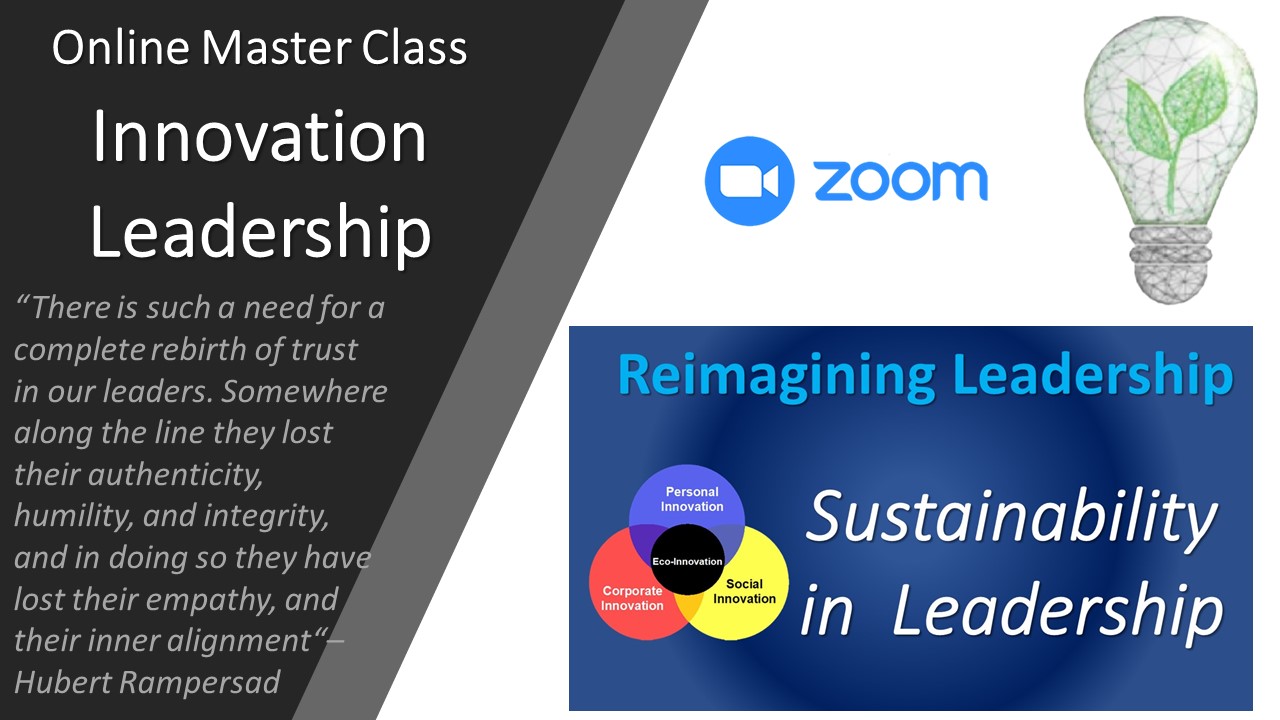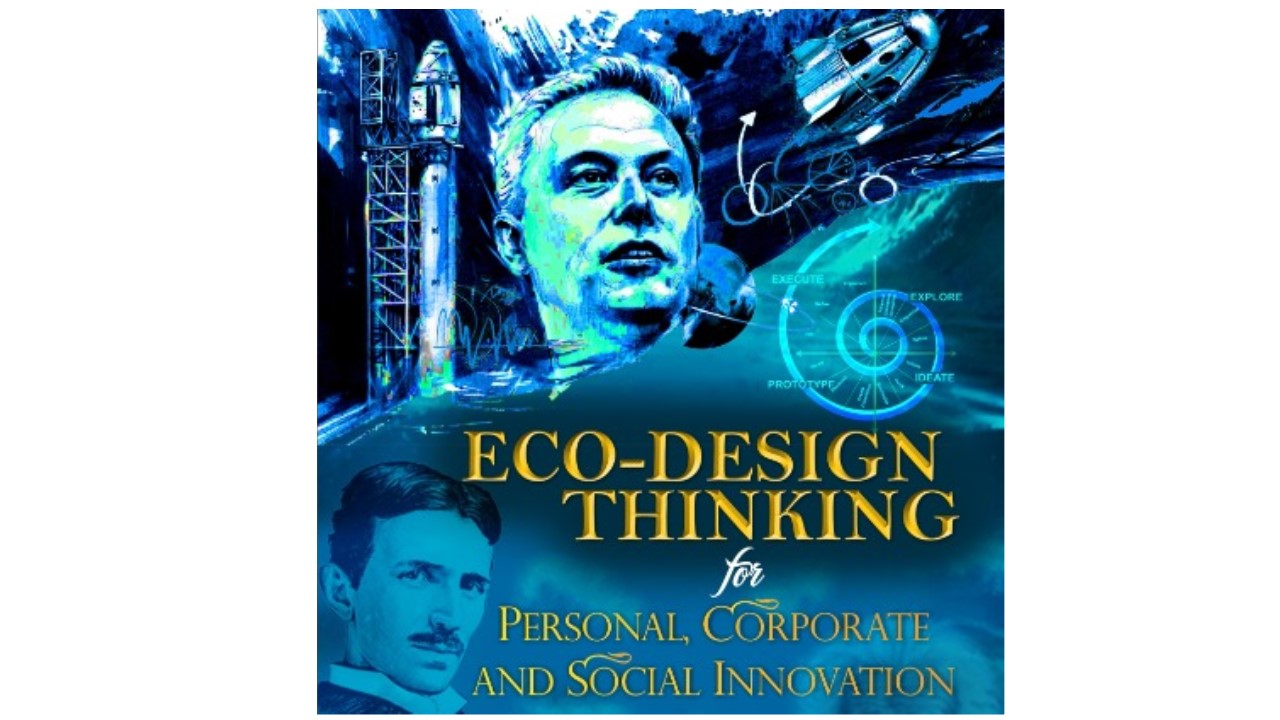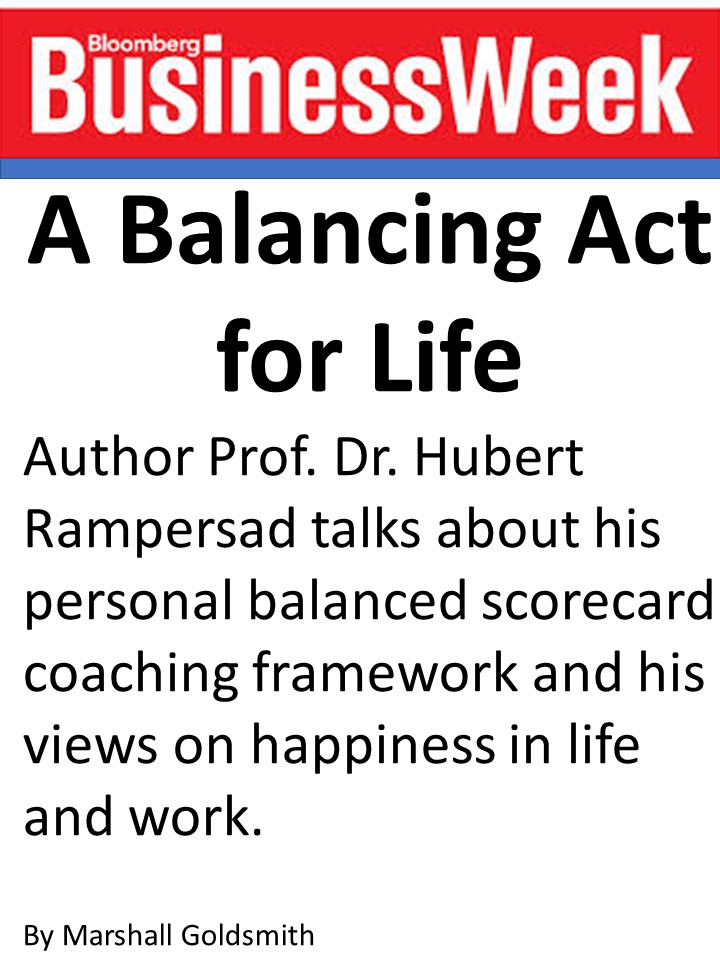Prof. Hubert Rampersad conducted a live webinar on “Eco-Design Thinking for Personal, Corporate, and Social Innovation” for the prestigious Design Lab at the University of California, San Diego, on 20 April 2022.

The UC San Diego Design Lab at the University of California is the home of interdisciplinary design. It’s focused on providing research, education, and community interaction to advance best practices in human-centered design and address complex societal problems. The UC San Diego Design Lab works on major societal issues, such as large-scale education, automation, healthcare, visualization of complex phenomena and data, social interactions, citizen science, and the ever-increasing importance of ethical issues. For the Design Lab, design is a way of thinking, addressing the core issues, always taking a systems point of view, and emphasizing people’s role in the modern world’s complex systems. The UC San Diego Design Lab is the world center for excellence in innovative design research and education.
 Prof. Rampersad also conducted a guest lecture in London for the prestigious Innovation Design Engineering (IDE) and Global Innovation Design (GID) students (two joint programs with Imperial College London and the prestigious Royal College of Art) on Monday, 21 February 2022
Prof. Rampersad also conducted a guest lecture in London for the prestigious Innovation Design Engineering (IDE) and Global Innovation Design (GID) students (two joint programs with Imperial College London and the prestigious Royal College of Art) on Monday, 21 February 2022 in the main lecture theatre at the Royal College of Art in South Kensington, London. Royal College of Art is the world’s most influential art and design postgraduate institution.
in the main lecture theatre at the Royal College of Art in South Kensington, London. Royal College of Art is the world’s most influential art and design postgraduate institution.

——————————————————————————-
Details about the topic:
Eco-Design Thinking for Personal, Corporate and Social Innovation
“Empathy is just what is needed to make the world a better place for all animals and humans. Personal integrity is the foundation of empathy, in which there is no room for ego”. — Hubert Rampersad
“Today’s complex world needs sustainable innovation. Traditional innovation approaches are not sustainable because they are not holistic. They are cosmetical, theatrical and cozy. They don’t fit in my definition of real sustainability: Sustainability is a holistic and ethical system in which humans and nature can exist in harmony for a very long period of time”— Hubert Rampersad.
Today’s complex world requires sustainable design & innovation. This related webinar is based on Dr. Hubert Rampersad’s new book “Eco-Design Thinking for Personal, Corporate and Social Innovation; How to Become a Disruptive Eco-Design Thinker Like Elon Musk“.
Rampersad’s new book “Eco-Design Thinking for Personal, Corporate and Social Innovation; How to Become a Disruptive Eco-Design Thinker Like Elon Musk“.
Please read his related articles “How to Design a Better World” and “Design For Sustainability“. “Sustainability is a holistic and ethical system in which humans and nature can exist in harmony for a very long period of time”– Hubert Rampersad
Read also “Sustainability in the Oil & Gas Industry“.
Remember what Einstein said: “We cannot solve our problems with the same thinking we used when we created them”. This new way of thinking entails eco-design thinking. Rampersad: “Eco-design thinking is the creative process of empathizing with yourself, the end user, and the environment“. Traditional design thinking approaches are not suitable for designing a better world. There are so many products badly designed, such as the rollout of vaccines in America, Citibank that lost $500 million because a user-unfriendly tool for managing loans, and the $2 trillion F-35 project. This Figure shows the top-10 causes of bad designs.

Traditional design thinking approaches lack sustainability because they are neither authentic nor holistic. Moreover, they are mainly process-driven, and focus on analytical thinking, such as how to follow design steps, organizing cozy meetings, how to complete related tasks in certain order, and how to use design tools. These approaches do not inspire imagination, creativity, and innovation sustainably.
For designing a better world, sustainably, you need a new design approach in which personal innovation, personal disruption, and personal integrity are embedded. It also requires eco-innovation that makes the link to personal innovation, corporate innovation, and social innovation.
The speaker will also elaborate on his new eco-innovation model that promotes eco-innovation through eco-design thinking.
new eco-innovation model that promotes eco-innovation through eco-design thinking.
Eco-design thinking for sustainable circular economy starts with personal innovation. It is about time to understand that without personal innovation you cannot be an emphatic eco-design thinker, and corporate innovation and social innovation will be cosmetic. Eco-design thinking includes imagination, which is a combination of convergent and divergent thought, and creative intuitive thinking. Creative intuitive thinking is iterative and cyclic, although analytical thinking is linear. Designing a better world requires a new way of thinking. The difference between traditional way of thinking and eco-design thinking is shown in this figure. It’s about a fixed mindset versus a growth mindset.

In his new book, the speaker has introduced an eco-design thinking model for designing innovative products and services that reflect all aspects of life effectively. Eco-design thinking is an iterative, incremental, cyclic, and concentric model of exploring, ideating, prototyping, and executing. The different stages in the eco-design thinking model often form iterative loops and do not necessarily follow any sequence.  Each iteration reveals new insights. This process should be repeated until the designer’s and customer’s issues are on an acceptable level. Rampersad: “Eco-design thinking is a circular and iterative process that never ends; it’s a continuous process of testing and refining your design, while empathizing with yourself, the user and the environment”.
Each iteration reveals new insights. This process should be repeated until the designer’s and customer’s issues are on an acceptable level. Rampersad: “Eco-design thinking is a circular and iterative process that never ends; it’s a continuous process of testing and refining your design, while empathizing with yourself, the user and the environment”.
 Eco-design thinking starts with his personal disruptive innovation concept to understand, explore and (re)design oneself before solving the design problem. First, you need to inculcate disruptive skills and become innovative and empathic in order to be able to develop innovative designs for the end users. Before you start designing products, you must first design yourself. Disruptors are innovative entrepreneurs and visionary idealists. To become a disruptive eco-design thinker like Elon Musk, you need to get a good understanding about yourself and design issue before exploring the design problem. Personal disruptive innovation (designing yourself) is based on the speaker’s 4 stage model:
Eco-design thinking starts with his personal disruptive innovation concept to understand, explore and (re)design oneself before solving the design problem. First, you need to inculcate disruptive skills and become innovative and empathic in order to be able to develop innovative designs for the end users. Before you start designing products, you must first design yourself. Disruptors are innovative entrepreneurs and visionary idealists. To become a disruptive eco-design thinker like Elon Musk, you need to get a good understanding about yourself and design issue before exploring the design problem. Personal disruptive innovation (designing yourself) is based on the speaker’s 4 stage model:
Read “4 Steps to Become Resilient and Cultivate a Growth Mindset“. This system unleashes your creative potential, creates new personal opportunities, disrupts your existing target market, and enables you to make a significant social impact. It is based on a framework and roadmap to build resilience, explore and (re)design your life, and develop your personal eco-design thinking brand and personal integrity. “The higher your personal integrity, the better your attentiveness, the better your empathic skills, the better your design, and the happier your customer”- Hubert Rampersad.
Moreover, it entails spiritual and emotional intelligence, unlocking the creative potential within you, and disrupting the normal course of your life. By applying the personal disruptive innovation model according to this PDAC-cycle, you will able to become visionary, imaginary, innovative, creative, and empathic:

Personal disruptive innovation will not only help you reframe your thinking but also transform yourself to become a disruptor. In this way you will not think outside the box, you will think like there is no box. It is about reinventing yourself, unleashing your creative potential, and changing your life by developing emotional intelligence and cultivating resilience within yourself. Personal disruptive innovation also entails a personal eco-design thinking branding system for effective storytelling in each stage in the design process.
potential, and changing your life by developing emotional intelligence and cultivating resilience within yourself. Personal disruptive innovation also entails a personal eco-design thinking branding system for effective storytelling in each stage in the design process.
“AI is the future of innovation that helps us generate more creative and imaginative ideas. However, it cannot replace human intelligence and empathy. Therefore, focusing on Personal Disruptive Innovation is imperative to develop critical thinking skills. This will enable us to keep up with AI, future-proof our careers, and adapt to unpredictable circumstances”.– Hubert Rampersad
The included personal eco-design thinking branding blueprint is meant to strengthen your storytelling, and to distinguish and separate yourself from the crowd. It shows what an eco-design thinking professional should do to succeed in the design industry and in life. Eco-design thinking also entails aligning personal innovation with corporate innovation, alignment with yourself (to enhance personal integrity and empathy) and alignment with your design team (to enhance designer’s engagement), as shown in this Figure:
For alignment with yourself, read his article “Reimagining Leadership“. Remember what Einstein said: “When you examine the lives of the most influential people who have ever walked among us, you discover one thread that winds through them all. They have been aligned first with their spiritual nature and only then with their physical selves.” For alignment with your design team, please read his articles “How to Enhance Employee Engagement and Design Team Performance at SpaceX and Tesla“ and “Aligning Personal Innovation with Corporate Innovation”.
alignment with your design team, please read his articles “How to Enhance Employee Engagement and Design Team Performance at SpaceX and Tesla“ and “Aligning Personal Innovation with Corporate Innovation”.
Rampersad believes in the importance of ethics in the design thinking industry and that the credibility and reputation of the design thinking profession are shaped by the collective conduct of individual design thinkers. Consequently, he has introduced the Eco-Design Thinking Code of Ethics to help designers to use their best ethical judgment.
conduct of individual design thinkers. Consequently, he has introduced the Eco-Design Thinking Code of Ethics to help designers to use their best ethical judgment.
Eco-design thinking is environmental, technological, social, ethical, and cultural; it is a people-centered, holistic and multidisciplinary approach that fits to the new normal. Rampersad therefore, provides the blueprint for establishing your own Eco-Design Thinking Lab to unlock the creative potential of your people and tackle complex design problems sustainably. By bringing your people and practitioners from all disciplines, perspectives, and backgrounds together in this lab you will make a real impact in society. This initiative will engage the practitioners in tackling real-world challenges, sustainably, with the help of provided eco-design thinking tool kit.
Join our Certified Eco-Design Thinking Practitioner program.
My quotes on sustainability and personal integrity illustrate my related thinking.

Read further his article “How to Embed SDG, ESG and Purpose in Design Thinking”.

Hubert Rampersad, Ph.D., is a visionary leader in innovative solutions for genuine sustainability, disruptive design innovation, critical thinking in the age of AI, authentic personal branding, and entrepreneurial leadership. He holds a Ph.D. in Innovation Sciences, an MSc in Technology Engineering & Robotics, and a BSc in Mechanical Engineering from leading accredited universities in the Netherlands/Europe (Delft University of Technology, Eindhoven University of Technology). He is a well-known futurist, advocating for genuine sustainability on a global scale. With extensive knowledge and expertise, he has authored 25 books on the topics above in many languages and is highly regarded for his insights in these fields. One of his books, “Total Performance Scorecard,” has been published in 20 languages. Dorothy Leonard, an innovation professor at Harvard Business School, wrote the book’s foreword. Rampersad has also previously served as a guest lecturer at MIT Sloan and was featured in BusinessWeek. He was a design innovation coach at ASML (the Most Important Tech Company in the World).

tpsi@live.com | Whatsapp: +13053992116 | Orlando, Florida About the author

















Muy interesante, involucrar el pensamiento holistico.
LikeLike